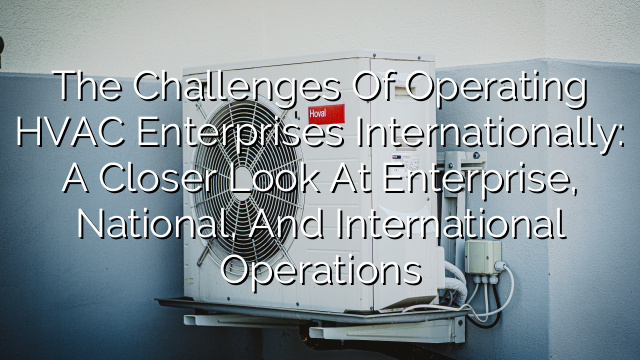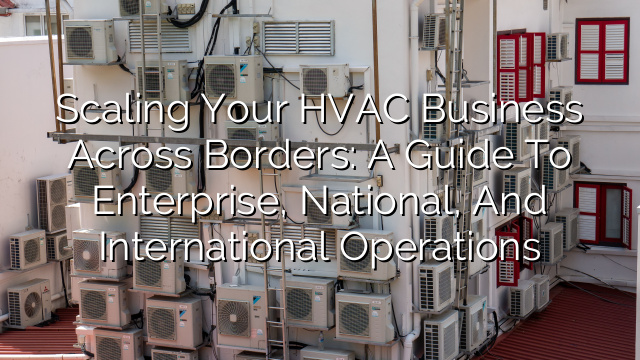Understanding Regional Differences in HVAC Operations for Enterprise and National and International Markets
Heating, ventilation, and air conditioning (HVAC) systems are vital for maintaining optimal indoor air quality and temperature in any building, whether it’s a small office or a large commercial facility. However, the way HVAC systems are designed and operated can vary significantly based on the region and the market they serve. In this blog post, we will explore the regional differences in HVAC operations for enterprise and national and international markets.
1. Regulation and Compliance
One of the most significant factors that influence HVAC operations is the regulatory environment and compliance standards in a particular region. Different countries and even different states or provinces within a country may have different regulations and requirements for HVAC systems. These regulations can encompass energy efficiency standards, refrigerant usage, emissions limits, and more.
In the European Union, for example, HVAC systems must comply with the Energy Efficiency Directive, which sets strict energy efficiency standards for heating and cooling equipment. On the other hand, in the United States, HVAC manufacturers and operators must follow the guidelines and regulations of organizations like the Environmental Protection Agency (EPA) and the American Society of Heating, Refrigerating and Air-Conditioning Engineers (ASHRAE).
2. Climate Considerations
The climate in a particular region also plays a crucial role in how HVAC systems are designed and operated. Buildings in hot and humid climates, such as those found in Southeast Asia, require robust cooling systems that can handle high humidity levels. In contrast, buildings in colder regions like Scandinavia may prioritize heating capabilities.
The climate also impacts the load calculations required for HVAC system sizing. For example, buildings in areas with mild winters may have smaller heating systems compared to those in regions with harsh winters. Heat recovery systems are also more prevalent in regions with large temperature differences between seasons, allowing for more efficient energy usage.
3. Infrastructure Availability
The availability of infrastructure, such as electricity, gas, and water, varies across regions, and this can impact HVAC operations. In some regions, electricity may be readily available and affordable, making electric-powered HVAC systems a common choice. In contrast, in areas with unreliable electricity supply, alternative power sources like diesel generators or natural gas may be preferred.
Water availability is also a consideration, especially in areas where water scarcity is a concern. In such regions, HVAC systems that use minimal or no water for cooling, such as air-cooled chillers, may be more prevalent.
4. Cultural and Architectural Factors
Cultural preferences and local architectural styles can also influence HVAC operations. For example, in many Asian countries, high humidity levels are a common issue. As a result, HVAC systems are often designed to prioritize humidity control along with temperature control. These systems may include additional dehumidification capabilities or advanced air filtration to provide optimal indoor air quality.
In addition, buildings with historical or architectural significance may have limitations on HVAC system installation. These limitations can impact the type and size of systems that can be implemented. In some cases, creative retrofitting or system integration may be required to ensure optimal HVAC operations while preserving the building’s architectural integrity.
5. Efficiency and Cost Considerations
Finally, regional differences in energy costs and efficiency concerns can impact HVAC operations. In regions with high energy costs, energy-efficient HVAC systems and equipment may be a priority to reduce operational expenses. This focus on efficiency may lead to the adoption of advanced technologies like variable refrigerant flow (VRF) systems, which offer precise temperature control and energy savings.
On the other hand, in areas with ample energy supply and lower energy costs, the upfront cost of HVAC systems may take precedence over energy efficiency considerations. This may result in the utilization of less energy-efficient systems, such as constant-volume or single-stage HVAC units.
FAQs
Q: Are there any global standards for HVAC operations?
A: While there are international organizations like ASHRAE that provide guidelines, there are no specific global standards for HVAC operations. Each country or region typically has its own regulations and compliance requirements.
Q: Can HVAC systems in different regions be easily interchanged?
A: HVAC systems are often designed and customized based on the specific needs of a region and its market. While basic HVAC principles remain the same, differences in regulations, climate, infrastructure, and cultural factors can make it challenging to interchange systems between regions without modifications or adaptations.
Q: Do international HVAC manufacturers cater to regional differences?
A: Yes, many international HVAC manufacturers offer products and solutions that are tailored to meet the specific requirements of different regions and markets. These manufacturers have expert knowledge and teams that can help customers choose and adapt HVAC systems according to their unique needs.
Q: How can businesses ensure optimal HVAC operations in different regions?
A: To ensure optimal HVAC operations in different regions, businesses should work with experienced HVAC professionals who have expertise in that specific market. These professionals can assess the building’s needs, factor in regional considerations, and design and install HVAC systems that are efficient and compliant with local regulations.
Q: Are there any future trends that will impact regional HVAC operations?
A: Yes, there are several future trends that will impact regional HVAC operations. These include the increasing adoption of smart and connected HVAC systems, the rise of renewable energy sources for HVAC operations, and a greater focus on sustainability and carbon emissions reduction.
Understanding regional differences in HVAC operations is crucial for businesses operating in enterprise and national and international markets. By considering factors such as regulation and compliance, climate, infrastructure availability, cultural and architectural factors, and efficiency and cost considerations, businesses can ensure that their HVAC systems are optimized for the specific needs of each region they serve.








